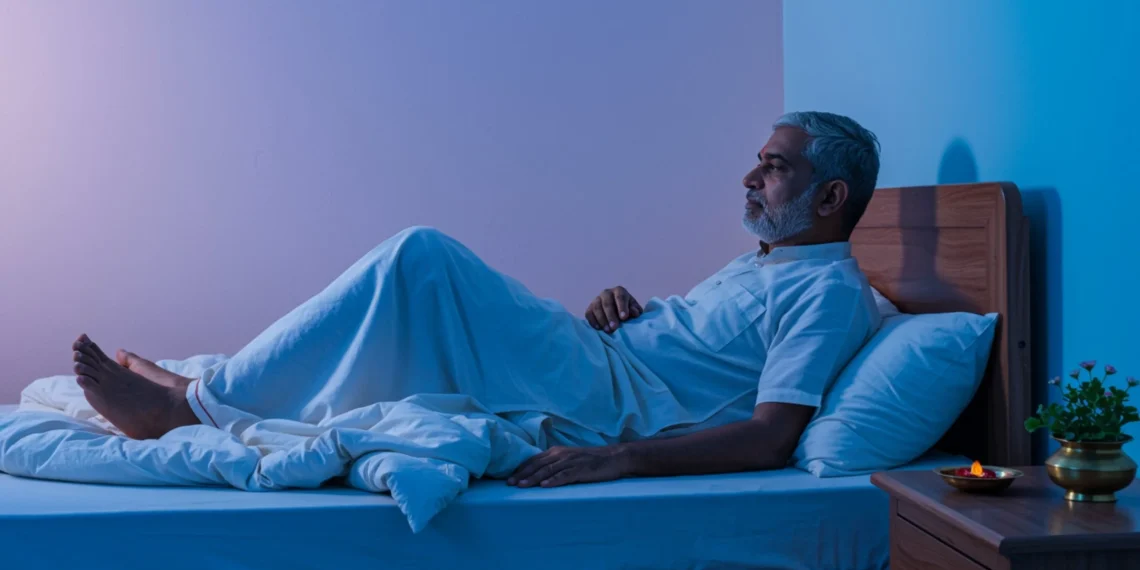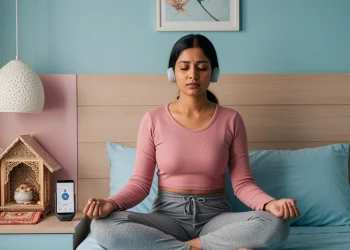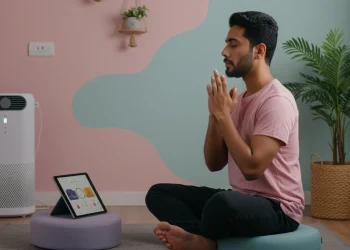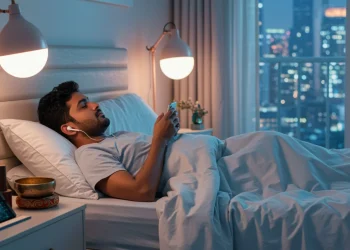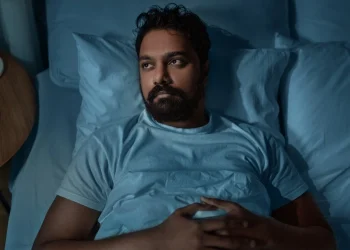Sleep movement disorders affect millions of Indians, yet many remain undiagnosed and untreated. Restless legs syndrome (RLS) and other sleep movement disorders disrupt not just individual rest but entire household harmony, a particularly significant concern in India’s joint family structures. This comprehensive guide explores these conditions through an Indian lens, combining ancient wellness practices with contemporary medical understanding.
Creating Comfortable Sleep Environments for Movement Disorders
The foundation of managing sleep movement disorders begins with thoughtful environmental design that accommodates involuntary movements while promoting restful sleep. In Indian homes, where space is often shared and families live in close proximity, creating an optimal sleep environment requires both practical solutions and cultural sensitivity.
Temperature regulation plays a crucial role in managing restless legs syndrome symptoms. Indian climates, ranging from humid coastal regions to dry northern plains, present unique challenges for those experiencing movement disorders. The ideal sleep temperature for RLS management typically falls between 18-22°C, yet many Indian households rely on ceiling fans or natural ventilation. Strategic placement of cooling solutions, such as positioning fans to create gentle air circulation without direct drafts, can significantly reduce symptom severity.
The choice of bedding materials becomes particularly important when dealing with movement disorders. Traditional Indian textiles like cotton khadi and handwoven fabrics offer excellent breathability, which is essential for temperature regulation. However, the texture and weight of bedding can either soothe or aggravate restless sensations. Smooth, lightweight cotton sheets allow for easier movement during episodes, while slightly weighted blankets can provide the deep pressure stimulation that many find calming.
Spatial arrangement within Indian bedrooms often reflects Vastu principles, which can be adapted to support those with movement disorders. Positioning the bed away from direct sunlight during evening hours helps maintain the natural circadian rhythm, while ensuring adequate space around the bed allows for safe movement during sleep. In joint families where multiple people share sleeping spaces, creating designated areas with movement-friendly arrangements becomes essential for everyone’s rest quality.
Sound management in Indian urban environments presents particular challenges for those with sleep movement disorders. Traffic noise, neighboring celebrations, and early morning activities can trigger or worsen symptoms. Incorporating traditional sound elements like gentle tabla rhythms or nature sounds familiar to Indian environments can mask disruptive noises while promoting relaxation. The key lies in finding sounds that feel culturally authentic while providing the consistent audio backdrop needed for symptom management.
Identifying Movement Disorders During Sleep in the Indian Context
Sleep movement disorders manifest differently across various populations, and Indian families often interpret these symptoms through cultural and familial lenses before seeking medical attention. Understanding these disorders requires recognizing both universal symptoms and culture-specific presentations that may influence diagnosis and treatment approaches.
Restless legs syndrome presents as uncomfortable sensations in the legs accompanied by an irresistible urge to move, typically worsening during evening hours. In Indian households where evening family time is sacred, these symptoms can significantly impact social interactions and family bonding. The timing of symptoms often coincides with traditional evening activities like family meals, television watching, or religious observances, making the condition particularly disruptive to cultural practices.
Periodic limb movement disorder, another common sleep movement condition, involves repetitive leg movements during sleep that can disrupt both the affected individual and their sleeping partner. In Indian joint families where married couples often share rooms with children or elderly relatives, these movements can affect multiple family members’ sleep quality. Understanding this ripple effect becomes crucial for comprehensive family-centered treatment approaches.
The diagnostic process in Indian healthcare settings often involves navigating between traditional healing systems and modern medical approaches. Many families first consult local practitioners, elderly relatives, or traditional healers before seeking formal medical evaluation. While this cultural approach has its merits, it can sometimes delay proper diagnosis of underlying conditions like iron deficiency or neurological disorders that contribute to movement disorders.
Recognizing the difference between occasional restlessness and diagnosable movement disorders requires attention to frequency, intensity, and impact on daily functioning. Cultural factors such as sleeping on floors, specific sleeping positions preferred in Indian households, and the use of traditional bedding can influence how symptoms present and are perceived by both patients and healthcare providers.
Nutritional Deficiencies and Sleep Movement Disorders in India
The relationship between nutrition and sleep movement disorders takes on particular significance in the Indian context, where dietary patterns, food availability, and traditional cooking methods influence nutritional status. Understanding these connections helps explain why certain movement disorders may be more prevalent or persistent in Indian populations.
Iron deficiency stands as the most well-documented nutritional factor contributing to restless legs syndrome, and India faces significant challenges with iron deficiency across various population segments. Traditional Indian diets, while rich in plant-based iron sources like lentils, spinach, and jaggery, often include compounds that inhibit iron absorption. The combination of high phytate content in whole grains, tannins in tea consumed with meals, and calcium from dairy products can significantly reduce iron bioavailability.
Vegetarian diets, practiced by a substantial portion of the Indian population, require careful planning to ensure adequate iron intake. While traditional combinations like consuming vitamin C-rich foods with iron sources show wisdom passed down through generations, modern lifestyle changes have sometimes disrupted these beneficial practices. The shift toward processed foods and irregular meal timings in urban India can exacerbate nutritional deficiencies that contribute to movement disorders.
Magnesium deficiency represents another significant factor in sleep movement disorders, and Indian diets traditionally provided adequate magnesium through whole grains, nuts, and leafy vegetables. However, soil depletion, food processing, and dietary changes have reduced magnesium intake in many Indian households. The mineral’s role in muscle relaxation and nervous system function makes it particularly important for managing movement disorders.
Vitamin D deficiency, increasingly common in urban Indian populations despite abundant sunlight, correlates with various sleep disorders including movement-related conditions. Cultural practices around sun exposure, particularly for women, combined with urban pollution and indoor lifestyles, contribute to widespread vitamin D inadequacy. This deficiency can worsen symptoms of restless legs syndrome and other movement disorders.
The timing of nutrient intake also influences sleep movement disorders. Traditional Indian meal patterns, with larger meals consumed earlier in the day, support better sleep quality. However, modern schedules often result in heavy evening meals that can worsen movement disorder symptoms. Understanding how traditional eating patterns supported better sleep can guide contemporary approaches to managing these conditions.
Iron Deficiency and Restless Legs Syndrome Connection
The relationship between iron deficiency and restless legs syndrome demonstrates how nutritional factors can significantly impact sleep quality, particularly relevant in India where iron deficiency affects large population segments across age groups and socioeconomic levels.
Iron plays a crucial role in dopamine production and function within the brain’s reward and movement control systems. When iron levels drop, dopamine synthesis becomes impaired, leading to the characteristic symptoms of restless legs syndrome. This connection explains why RLS symptoms often worsen during periods of increased iron demand, such as pregnancy, adolescence, or recovery from illness.
In Indian women, iron deficiency often develops during reproductive years due to menstrual losses, dietary restrictions, and increased demands during pregnancy and breastfeeding. Cultural practices around menstruation, including temporary dietary restrictions in some communities, can exacerbate iron deficiency. Understanding these cultural factors becomes essential for healthcare providers developing treatment plans that respect traditional practices while addressing nutritional needs.
Traditional Indian cooking methods using iron vessels actually provided supplemental iron, a practice that has largely disappeared with the adoption of stainless steel and aluminum cookware. The shift away from iron cooking vessels represents one factor contributing to reduced iron intake in modern Indian households. Encouraging the return to iron cookware, when culturally appropriate, can provide a simple intervention for improving iron status.
The bioavailability of iron from Indian vegetarian sources requires strategic meal planning to maximize absorption. Traditional food combinations demonstrate ancestral wisdom about nutrition optimization. Consuming iron-rich foods like dal with vitamin C sources such as tomatoes, citrus fruits, or bell peppers enhances absorption. Similarly, avoiding tea or coffee consumption immediately after iron-rich meals prevents tannin interference with iron uptake.
Screening for iron deficiency in individuals presenting with restless legs syndrome should include not just hemoglobin levels but also ferritin, which better reflects iron stores. Indian healthcare systems increasingly recognize the importance of comprehensive iron status evaluation, particularly given the high prevalence of iron deficiency even among individuals with normal hemoglobin levels.
Traditional Treatments and Modern Approaches
The integration of traditional Indian healing systems with contemporary medical treatments offers a comprehensive approach to managing sleep movement disorders that respects cultural values while providing evidence-based care.
Ayurvedic medicine recognizes sleep disorders as manifestations of Vata imbalance, characterized by increased movement, restlessness, and nervous system hyperactivity. Traditional treatments focus on Vata pacification through specific herbs, oil treatments, and lifestyle modifications. Herbs like Ashwagandha (Withania somnifera) demonstrate modern research validation for their sleep-promoting and muscle-relaxing properties, bridging traditional wisdom with contemporary understanding.
Abhyanga, the traditional practice of oil massage, provides therapeutic benefits that align with modern understanding of deep pressure therapy for movement disorders. The practice of massaging legs with warm sesame oil before sleep can reduce restless sensations while promoting relaxation. This traditional approach offers a family-friendly, accessible intervention that can be easily incorporated into Indian household routines.
Panchakarma therapies, particularly Shirodhara (continuous oil pouring over the forehead) and Padabhyanga (foot massage), target nervous system relaxation and can significantly benefit individuals with movement disorders. These treatments, when provided by qualified practitioners, offer profound relaxation benefits that extend beyond symptom management to overall nervous system health.
Modern medical approaches to sleep movement disorders include medications like dopamine agonists, gabapentinoids, and iron supplementation when deficiency is present. The integration of these treatments with traditional approaches requires careful coordination to avoid interactions and maximize therapeutic benefits. Healthcare providers increasingly recognize the value of combining conventional treatments with traditional practices that patients find culturally meaningful.
Sleep hygiene education adapted for Indian contexts considers family structures, religious practices, and cultural sleep preferences. Recommendations might include modifications to traditional evening prayers to include relaxation techniques, adapting festival sleeping arrangements to accommodate movement disorders, and working with family schedules to support consistent sleep timing.
Exercise and Yoga for Symptom Management
Physical activity and yoga practice offer powerful tools for managing sleep movement disorders, with Indian traditions providing particularly relevant approaches that address both physical symptoms and underlying imbalances.
Yoga asanas (postures) specifically targeting leg circulation and nervous system relaxation can significantly reduce restless legs syndrome symptoms. Gentle inversions like Viparita Karani (legs up the wall) improve venous return and reduce leg discomfort. This practice, accessible to most individuals regardless of fitness level, can be performed in the evening as part of a pre-sleep routine.
Pranayama (breathing practices) addresses the nervous system hyperactivity underlying many movement disorders. Techniques like Nadi Shodhana (alternate nostril breathing) and Bhramari (humming bee breath) activate the parasympathetic nervous system, promoting relaxation and reducing symptom severity. These practices require no equipment and can be learned by family members to create a supportive practice environment.
Regular walking, deeply embedded in Indian culture through practices like evening walks and pilgrimage traditions, provides moderate exercise that can reduce movement disorder symptoms. The timing of exercise becomes crucial, as vigorous activity close to bedtime can worsen symptoms. Traditional practices of gentle evening walks, often taken with family members, align perfectly with therapeutic recommendations for movement disorder management.
Specific yoga sequences designed for evening practice can address the timing patterns of restless legs syndrome. Gentle stretching sequences focusing on hip flexors, hamstrings, and calf muscles help release tension that contributes to restless sensations. These practices can be adapted for performance on beds or floor surfaces common in Indian sleeping arrangements.
The mindfulness component of yoga practice provides additional benefits for managing the anxiety and frustration often associated with movement disorders. Meditation practices help individuals develop new relationships with uncomfortable sensations, reducing the distress that can worsen symptoms. This psychological component often proves as important as the physical benefits of yoga practice.
Lifestyle Modifications for Indian Families
Managing sleep movement disorders within Indian family structures requires modifications that consider joint living arrangements, cultural practices, and traditional daily rhythms while supporting optimal sleep health for affected individuals.
Evening routine modifications must balance individual therapeutic needs with family time and cultural practices. Creating personalized pre-sleep routines that incorporate relaxation techniques while allowing for family participation can strengthen both therapeutic outcomes and family bonds. This might include family meditation time, gentle music listening, or shared reading practices that benefit everyone while specifically supporting the individual with movement disorders.
Dietary timing adjustments consider traditional Indian meal patterns while optimizing symptom management. Light evening meals, consumed at least three hours before sleep, reduce the likelihood of symptom exacerbation while respecting cultural preferences for family dining. Strategic timing of iron-rich foods earlier in the day, when absorption is optimal, supports nutritional therapy while maintaining traditional cooking practices.
Sleep scheduling in joint families requires communication and cooperation to ensure the affected individual can maintain consistent sleep and wake times. This might involve adjusting evening television viewing, modifying morning prayer schedules, or creating quiet zones during critical sleep periods. The family-centered approach inherent in Indian culture can become a therapeutic asset when properly channeled.
Technology use management becomes particularly important in Indian households where multiple generations share living spaces and entertainment devices. Establishing screen time boundaries that support healthy sleep hygiene while respecting different family members’ needs requires careful planning and compromise. Creating designated charging areas away from sleeping spaces helps maintain the bedroom environment optimal for rest.
Stress management within Indian family contexts often involves addressing relationship dynamics, financial pressures, and cultural expectations that can worsen movement disorder symptoms. Family counseling approaches that respect hierarchical structures while promoting understanding of medical conditions can significantly improve treatment outcomes. Education about movement disorders helps family members provide appropriate support while maintaining cultural values.
The integration of traditional wellness practices with modern medical management creates comprehensive care plans that feel authentic to Indian families while providing effective symptom relief. This approach honors cultural wisdom while embracing scientific understanding, creating sustainable long-term management strategies for sleep movement disorders.
Regular follow-up and monitoring consider both medical outcomes and cultural satisfaction with treatment approaches. Healthcare providers working with Indian families often find that treatments incorporating familiar cultural elements show better adherence and outcomes than purely Western medical approaches.
Understanding sleep movement disorders through an Indian perspective requires appreciating the complex interplay between traditional practices, modern challenges, nutritional factors, and family dynamics. By integrating ancient wisdom with contemporary medical knowledge, individuals and families can develop comprehensive approaches to managing these conditions while honoring their cultural values and improving overall sleep quality for everyone involved.
For personalized guidance on managing sleep movement disorders, consider consulting with healthcare providers familiar with both traditional and modern approaches to sleep medicine. Sweet dreams begin with understanding, preparation, and the right support system.
